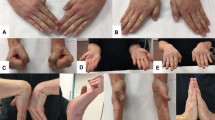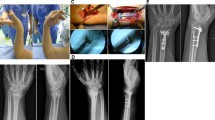Abstract
Background: Volar and/or dorsal surgical approaches are used for surgical treatment of perilunate and lunate dislocations. There are no accepted approaches for treatment in the literature. We evaluated the functional results of isolated volar surgical approach for the treatment of perilunate and lunate dislocation injuries.
Materials and Methods: 9 patients (6 male and 3 female patients average age 34.5 ± 3.6 years) diagnosed with perilunate or lunate dislocations between January 2000 and January 2009 were involved in the study. The reduction was performed through isolated volar surgical approach and K-wire fixation, fracture stabilization with volar ligament repair was performed. Range of wrist joint motion, fracture healing, carpal stability, grip strength, return to work were evaluated and also direct radiographs were taken routinely at each control. The scapholunate interval and the scapholunate angle were evaluated radiographically. Evaluations of the clinical results were done using the DASH, VAS and Modified Mayo Wrist Scores.
Results: The physical rehabilitation was started at 6th week, after the K-wires were removed. The average followup was 18.2 months (range 12–28 months). At the final followup, the average flexion extension arc was 105.0 ± 9.6° (74.6% of the other side), the average rotation arc was 138.8 ± 7.8° (81.5% of the other side) and the average radioulnar arc was 56.1 ± 9.9° (86.4% of the other side). The grip strength was 0.55 bar; 83.2% that the uninjured arm. According to the Mayo Modified Wrist score, the functional result was excellent in five patients and good in four and the average DASH score was 22.8. The scapholunate interval was 2.1 mm and scapholunate angle was 51°.
Conclusion: The clinical and radiological results of the isolated volar surgical approach were satisfactory. The dorsal approach was not needed for reduction of dislocations during operations. Our results showed that an isolated volar approach was adequate.
Similar content being viewed by others
References
Dobyns JH, Linscheid RL. Fractures and dislocations of the wrist. In: Rockwood and Green (Ed): Fractures in adults, 6th ed. Philadelphia, J B Lippincott; 2006. p. 858–909.
Kennedy SA, Allan CH. In brief: Mayfield JK, Johnson RP, Kilcoyne RK. Classification: Carpal dislocations and progressive perilunar instability. Clin Orthop Relat Res 2012;470:1243–5.
Cooney WP, Bussey R, Dobyns JH, Linscheid RL. Difficult wrist fractures. Perilunate fracture-dislocations of the wrist. Difficult wrist fractures 1987;214:136–47.
Sotereanos DG, Mitsionis GJ, Giannakopoulos PN, Tomaino MM, Herndon JH. Perilunate dislocation and fracture dislocation: A critical analysis of the volar-dorsal approach. J Hand Surg 1997;22:49–56.
Melone CP, Murphy MS, Raskin KB. Perilunate injuries. Repair by dual dorsal and volar approaches. Perilunate injuries 2000;16:439–48.
Chou YC, Hsu YH, Cheng CY, Wu CC. Percutaneous screw and axial Kirschner wire fixation for acute transscaphoid perilunate fracture dislocation. J Hand Surg 2012;37:715–20.
Inoue G, Kuwahata Y. Management of acute perilunate dislocations without fracture of the scaphoid. J Hand Surg 1997;22:647–52.
DiGiovanni B, Shaffer J. Treatment of perilunate and transscaphoid perilunate dislocations of the wrist. Am J Orthop 1995;24:818–26.
Melsom DS, Leslie IJ. Carpal dislocations. Curr Orthop 2007;21:288–97.
Palmar AK, Dobyns JH, Linscheid RL. Management of posttraumatic instability of the wrist secondary to ligament rupture. J Hand Surgery 1978;3:507–32.
Laporte M, Michot A, Choughri H, Abi-Chahla ML, Pelissier P. Perilunate dislocations and fracture-dislocations of the wrist, a review of 17 cases. Chir Main 2012;31:62–70.
Herzberg G, Comtet JJ, Linscheid RL, Amadio PC, Cooney WP, Stalder J. Perilunate dislocations and fracture-dislocations: A multicenter study. J Hand Surg 1993;18:768–79.
Herzberg G, Forissier D. Acute dorsal trans-scaphoid perilunate fracture-dislocations: Medium-term results. J Hand Surg 2002;27:498–502.
Apergis E, Maris J, Theodoratos G, Pavlakis D, Antoniou N. Perilunate dislocations and fracture-dislocations: Closed and early open reduction compared in 28 cases. Acta Orthop Scand 1997;275:55–9.
Adkison JW, Chapman MW. Treatment of acute lunate and perilunate dislocations. Clin Orthop 1982;164:199–207.
Knoll VD, Allan C, Trumble TE. Trans-scaphoid perilunate fracture dislocations: Results of screw fixation of the scaphoid and lunotriquetral repair with a dorsal approach. J Hand Surg 2005;30:1145–52.
Lutz M, Arora R, Kammerlander C, Gabl M, Pechlaner S. Stabilization of perilunate and transscaphoid perilunate fracture-dislocations via a combined palmar and dorsal approach. Oper Orthop Traumatol 2009;21:442–58.
Trumble TE, Bour CJ, Smith RJ, Glisson RR. Kinematics of the ulnar carpus related to the intercalated segment instability pattern. J Hand Surg 1990;15:384–92.
Malović M, Pavić R, Milosević M. Treatment of trans-scaphoid perilunate dislocations using a volar approach with scaphoid osteosynthesis and temporary Kirschner wire fixation. Mil Med 2011;176:1077–82.
Minami A, Ogino T, Ohshio I, Minami M. Correlation between clinical results and carpal instabilities in patients after reduction of lunate and perilunate dislocations. J Hand Surg 1986;11:213–20.
Cohen MS, Kozin SH. Degenerative arthritis of the wrist: Proximal row carpectomy versus scaphoid excision and four corner arthrodesis. J Hand Surg 2001;26:94–104.
Rettig ME, Raskin KB. Long term assessment of proximal row carpectomy for chronic perilunate dislocations. J Hand Surg 1999;24:1231–6.
İnoue G, Shionoya K. Late treatment of unreduced perilunate dislocations. J Hand Surg 1999;24:221–5
Author information
Authors and Affiliations
Corresponding author
Rights and permissions
About this article
Cite this article
Başar, H., Başar, B., Erol, B. et al. Isolated volar surgical approach for the treatment of perilunate and lunate dislocations. IJOO 48, 301–305 (2014). https://doi.org/10.4103/0019-5413.132523
Published:
Issue Date:
DOI: https://doi.org/10.4103/0019-5413.132523




